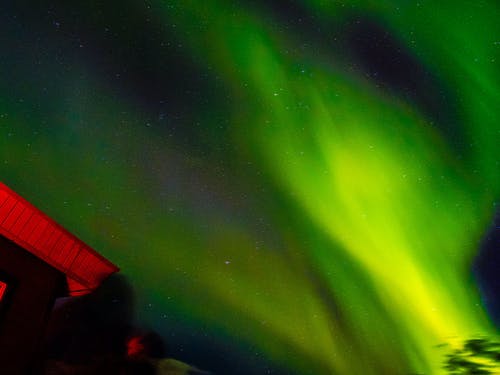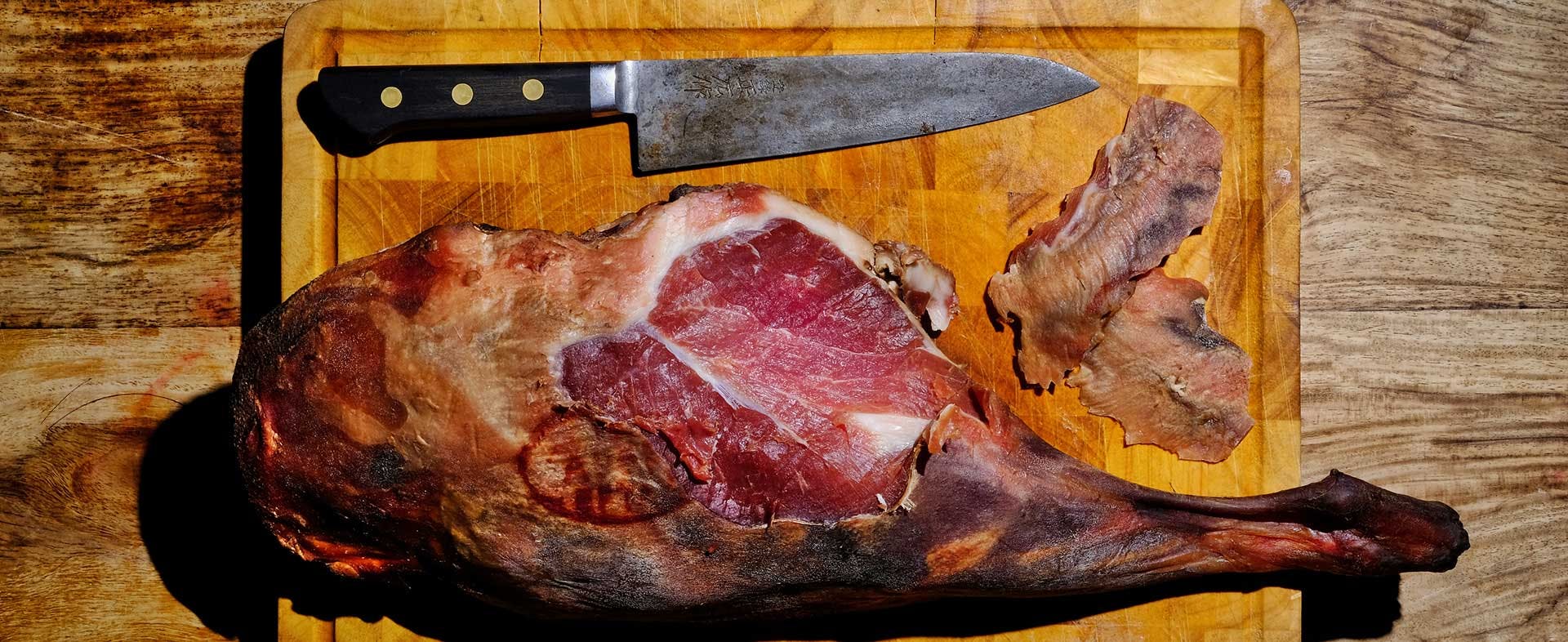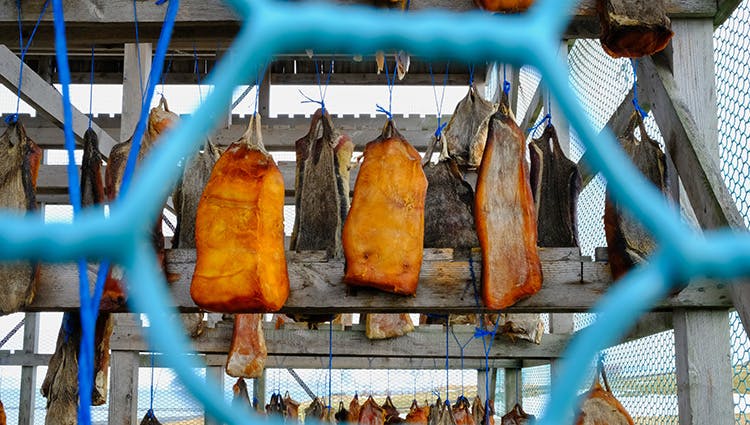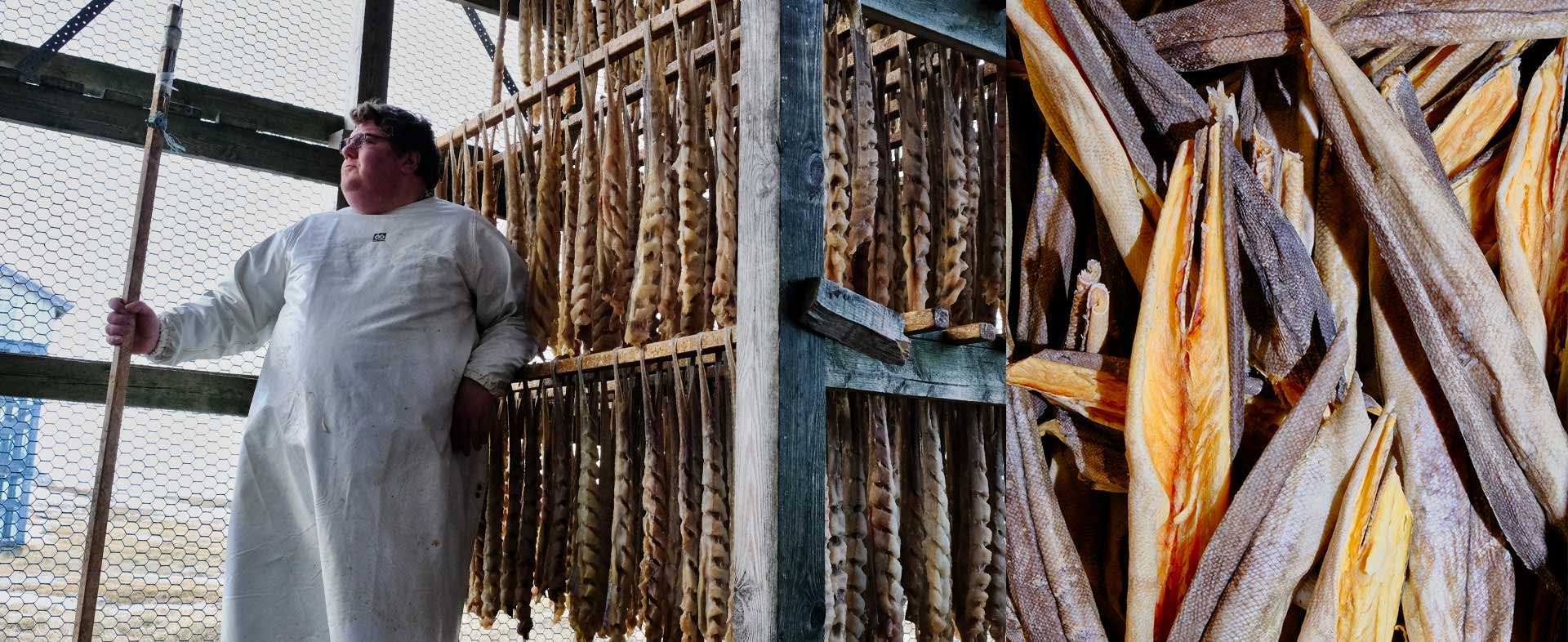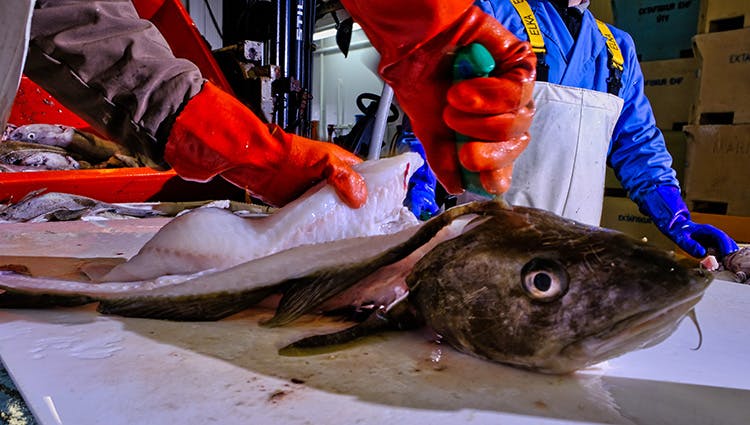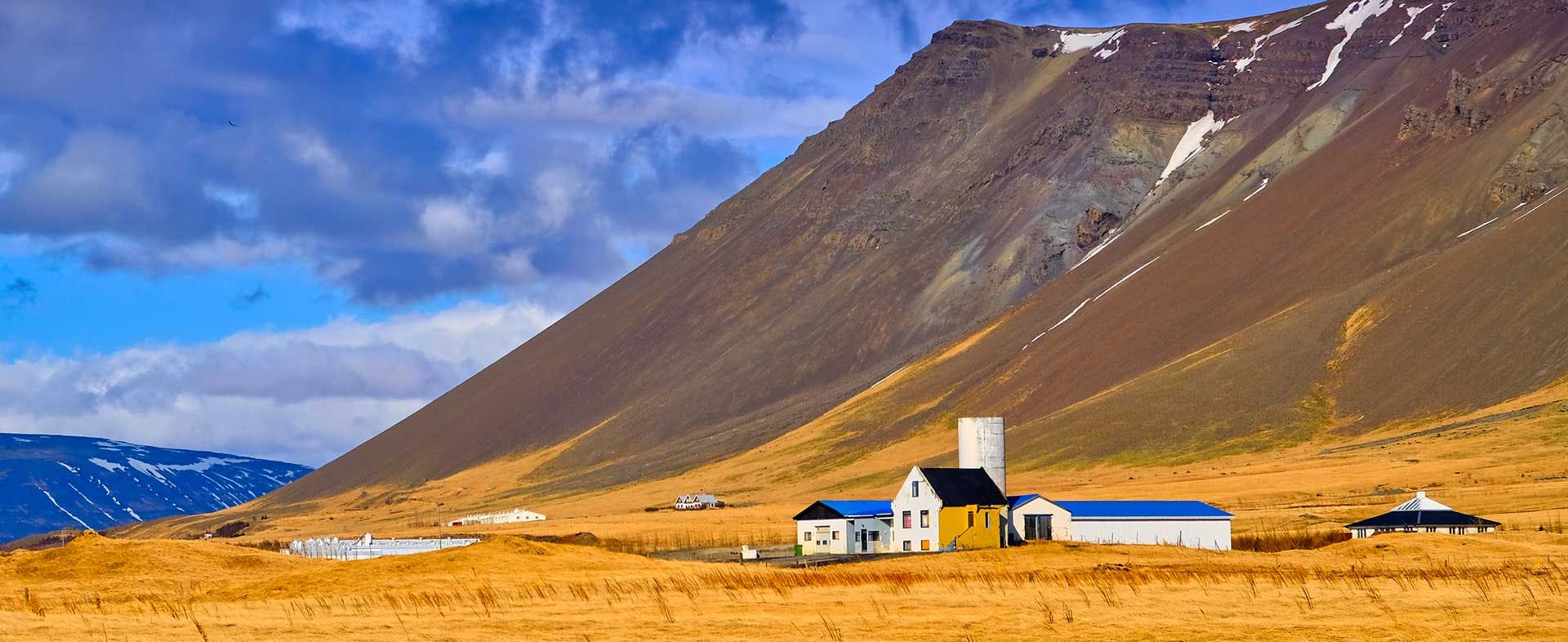“Fire—it's the only real magic that's left in the world," Hjörleifur Stefánsson, a young, pony-tailed wizard-cum-farmer, said as he danced around searing mutton chops engulfed in a minor blaze. Looking around, I wasn't sure that it was the only magic left. The green and purple waves of the aurora borealis frolicked in the sky, while sheep bayed from somewhere over a shimmering fjord. This place was like Vermont on Mars.
For an island country that has the population roughly of Corpus Christi, Texas, Iceland has an outsize influence on the world. Seemingly, everyone wants to go or has gone—more than four million people visit every year. Giving in to the FOMO, I recently decided to become one of them. I sought the guidance of the uber-Icelandic chef, Gunnar Karl Gíslason of NYC's Agern, who devised a rambunctious journey for me up the craggy west coast and to the north, to experience the traditional foodstuffs of their little-known cuisine.
I.
"We are Vikings," Hinni Carl Ellertsson, the stout brewmaster of Kex Brewing in Reykjavík, said with a wry smile, when I asked him about the insane popularity of Iceland. "We steal the best from everyone."
"Ah, we're not there yet, Hinni!" Oli Agustsson, one of the maestros of the mini Kex empire (Michelin-starred Dill, Holt and the Kex Hostel among the group), responded. "We have three to four restaurants that are good in Iceland, 25 that aren't—we're slowly getting there."
We sipped on heady Imperial Stouts, brewed with cocoa, vanilla and salt from the Saltverk in the Westfjords, and experienced a brief monk-like silence. Ellertsson explained that as a former chef, he can't help but salt the beer a little bit—it opens up the flavor.
"Oli is right—the financial crisis in 2008 helped us a lot," Ellertsson continued. "Places here were putting crocodile and kangaroo on their menus before, even importing fish—so stupid for an island. Now we are more focused."
We went on to discuss my trip. Ellertsson got up to trace where I was going on a huge wall map of Iceland made unironically from beer caps. All agreed that I was going to see some real-deal Icelandic producers, and what's more, they seemed to know all of them. (Very quickly, it can seem like everybody here is a cousin of some sort. An app called Íslendingabók—aka "The Book of Iceland"—which traces virtually all of the island's genealogical history, is rabidly popular and often used as a maybe-too-revealing party game.) It kind of seemed like an Icelandic-ization of Iceland was well on its way. I was game.
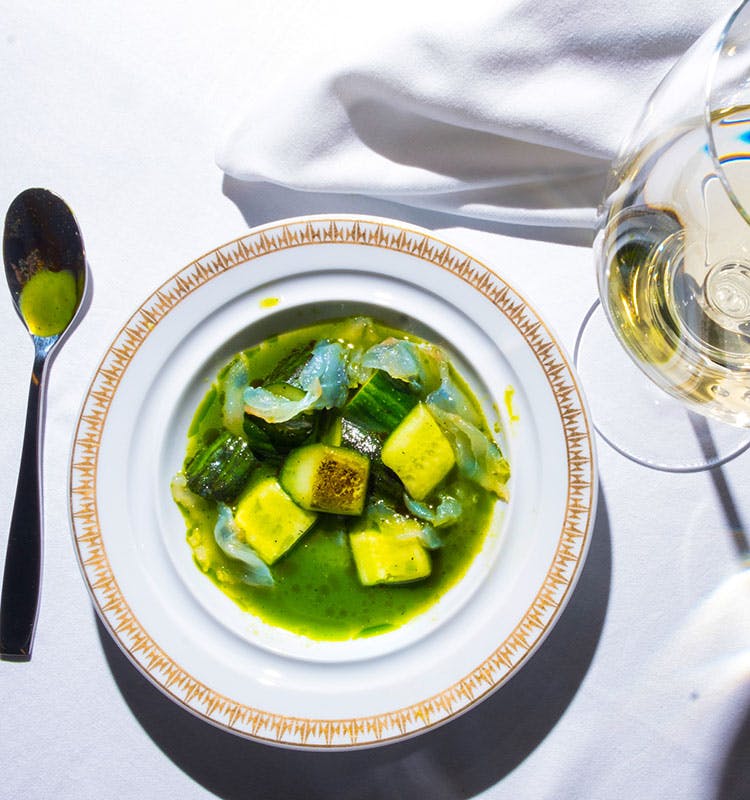
II.
Later that day, I was ensconced in a formfitting leather chair in the Hotel Holt, sipping more Kex beer while waiting for dinner at the restaurant. Surrounded by paintings of forlorn sailors and ships bobbing in storm swells, the musky lounge was like something straight out of Mad Men: Nordic Edition. In fact, the hotel which is from 1965, has a status that prohibits anything from being changed in the interior. Ever.
"Welcome to the first-ever chef's-table dinner in Iceland," chef Ragnar Eiríksson said, holding his arms open wide as he welcomed me into the kitchen. I stiffened my spine and got ready for the cucumber gazpacho draped with translucent slices of raw cod. It was bright and herbaceous and bracing.
Fresh from working at Dill, where there are no open flames, Eiríksson was experiencing a chef's rebirth at the newly opened restaurant. "I can finally cook like a person again," he said with a slightly crazy laugh. Up until recently, the restaurant had served a kind of quaint, French-y continental fare, when the owner decided she'd had enough and brought in the cool kids from the Kex group to Icelandic it up. Change in a place that can't change seems pretty hard, but they are doing well, I thought, as I bit into a dish of grilled baby Gem lettuce splayed open with an extravagant amount of varicolored caviar. Holt definitely seemed like a place that will define what dining in Iceland will be.
III.
The next morning, I was driving north with a leg of lamb wrapped like a mummy as my passenger. Agustsson had given it to me as a present for his cousin, Stefánsson (the wizard farmer previously mentioned), who I was going to visit at his inn called Ensku Húsin (or the "English House," an elegant old fishing lodge on the river Langa).
As soon as I handed him the gift, he broke out laughing. "What? You brought what?! I sold Oli this last year!" Stefánsson bellowed. Apparently, I was part of an elaborate lamb-swapping Icelandic prank. He quickly unwrapped it and cut off a few slices for us to taste. Salty and sweet, like a smoked prosciutto but lamb. We hopped into his truck, so he could show me where he made it, arriving at a shack stuffed with salmon fillets and smoke billowing out its cracks.
"This lamb was three bloody weeks in this hut," he said. "It was my great-uncle's chicken coop, but then it got a promotion." Stefánsson's family has been on the property where he lives for five generations—they even have an ancient registered earmark for their sheep called eyirnamork.
"I don't add sugar to the lamb when I cure it," he continued. "The sheep dung we use to smoke has a kind of sweet tang to it." Later that evening, he grilled mutton for dinner. Tradition is very important to him and he wants to make sure it's passed on to his sons. While he was flipping the mutton, he regaled me with stories from the past. "My grandparents made the cured lamb the same way. They lived in turf houses, and it hung up below the chimney."
He was frustrated that some Icelandic foods got relegated to BuzzFeed gross-out listicles. Pickled ram's testicles ("It's just like a bag of chips for me") and fermented shark ("My grandfather would cut off a piece after having a breakfast of porridge with sea bird") are part of his heritage, and he expressed that he feels responsible for the current generation. "It's just food! I want our culture to seep into my boys," he said. Not surprising for someone who told me later, "I believe in Thor, when it suits me." I wanted that for his boys, too.
IV.
As I began the drive the next day to Ísafjörður, an isolated fishing village in the far northwest of the country, it was hard to discern between what was sky and what was land. A winter wonderland: And it wasn't even winter. One minute, there was blurring snow; the next, a beachside scene riddled with shards of ice, seaweed and mussel shells.
Once in town—a seaside oasis hanging off the edge of the world—I met with Guomundur Gelgason, or "Gummi", a local chef who promptly took me to his restaurant, Edinborg Bistró, for a plate of whale blubber, sheep's-head jelly and fermented shark. "There used to be no refrigeration," Gummi said. "Some months you couldn't even fish—it was all ice. This was all there was to eat, all fermented with whey."
In the summer, he has to cater to tourists with puffin pizza and whale steak, but he was more excited about his new pizzeria, the only one in town. Together, we dined on a pie called Mr. President that was covered with pineapple—so named because the current president of Iceland jokingly said in an interview that pineapple on pizza should be outlawed (which, to put it mildly, didn't go over very well).
V.
In the morning, Gummi led me to meet Gunnlaugur Finnbogason Gulli, a second-generation harðfiskur (air-dried fish) maker in town. This was as old school as it got. When I asked how long it takes to make it, he said, "Depends on the wind." Undoubtedly a rarity for a commercial enterprise. "It's like beef jerky from fish," Gummi said about the supple, creamy haddock. "I eat it with butter; it's very good." Sounds strange until you break it down into an easy-to-manage lox-with-a-cream-cheese-schmear equation.
Gulli took me up to where the fish dry from October to May. Overlooking the sea, his open-air facility—which looked like a giant, three-story chicken-wire-meshed tree fort—would be prime real estate anywhere else. Hanging in the thousands were cured, drying fillets of haddock and cod. The air was fresh and clean. A local sixth -eneration resident, Porbjorn Halldor Johannessan, ambled up to me as a welcome curiosity. "There used to be so much snow here that you could only walk to town once a week," he bragged. And then: "See that mountain over there? I own half of it." Got it.
VI.
"Many people have survived this visit before," Elvar Reykjalin, the owner of Ektafiskur, a bacalhau maker near Akureyri, said. I wasn't sure what he meant, until moments later, he was gripping a cod eyeball in his teeth. Nevertheless, his process is so pristine and beautiful that restaurants all over the world use his salted cod.
I caught him in the middle of filleting cod with his uncle and niece; the fish had been caught by his brothers the day before. Fish is in Reykjalin's blood: He started 15 years ago as a deckhand, cook, and then first mate. He poured us DayQuil-esque homemade schnapps as we walked around his facility. It was like a Ripley's Believe It or Not! of seafood wonders. (Ask to see the Greenland shark's head, gulp.)
Reykjalin explained how the cod is packed in salt until preserved, and then rinsed and soaked in glacial water before being shipped out to the world. But, more importantly, he seemed intent on our having more schnapps. And fermented shark. "I think many Icelanders justify eating this shark just for the schnapps," Reykjalin said, grinning as wide as humanly possible.
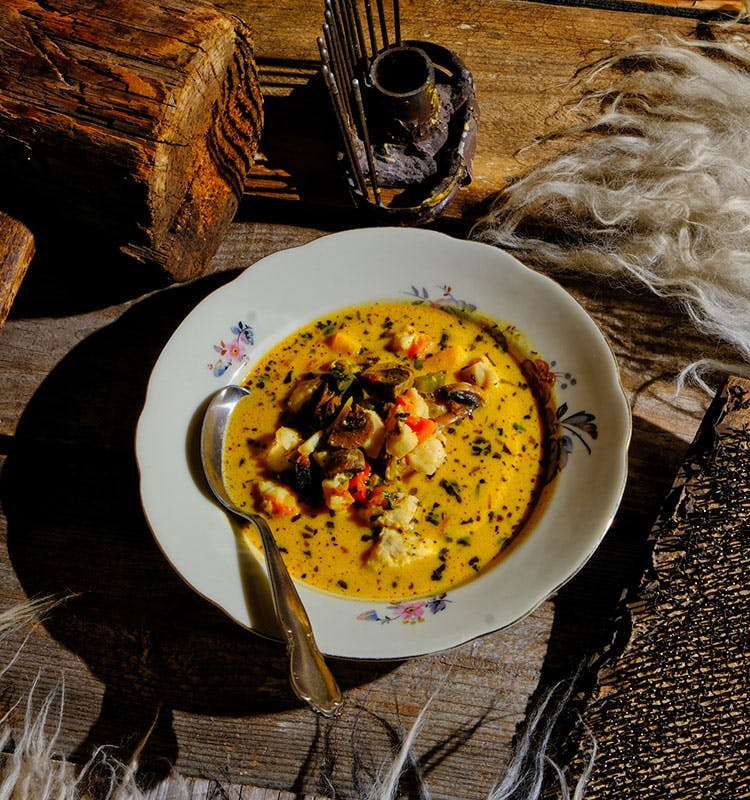
VII.
I headed over to the nearby Dalvík Vegamót Cottages to eat and rest. Bjarni Gunnarsson and his wife, Kristin Simonardottir, the owners, were happy to see me as we ate their fish soup, replete with cream, turmeric and a secret—although you'd never know it—ingredient. Peaches. Peculiar, yes, but delicious enough to have a second, even third helping.
Gunnarsson, with his beard and high spirit, led me over to meet a local friend, Sigurdur Jorgen Oskarsson (who runs the nearby fish plant), and told me that many of his guests come here only to see the northern lights. "I've had them actually ask me to turn them on, like I have a light switch."
Talking to Gunnarsson and Oskarsson, it seemed like the future of Iceland was tied to how they've cooked fish over time. "When I was a kid and we had fish, it was boiled aggressively like potatoes," Oskarsson laughed. "It would have been more nutritious to drink the water than eat the fish."
Now, he said, what is happening is amazing: They cherish and take care of the delicate harvest from the sea. "Look, we are an insecure country still—just the other day we were living in turf houses. It's like when Bobby Fischer came here for the Match of the Century," he said. "They asked as soon as he set foot off the airplane, 'What do you think of Iceland?'"
Today, the outside affirmation is overflowing. It's seen as a paradise of ingredients and culture. And I love it.
